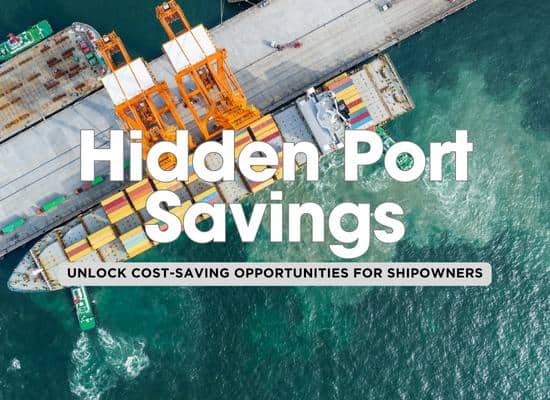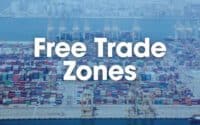15 Port Rebates and Incentives Every Shipowner Should Know About

Managing a commercial fleet is a balancing act—every dollar saved can directly boost your bottom line. But did you know that many ports offer hidden incentives to reward shipowners who prioritize sustainability, efficiency, and innovation? From eco-friendly discounts to volume-based rebates, these 15 programs provide real and sometimes substantial savings. 💸✨

1. Eco-Friendly Discounts 🌍
Ports worldwide are leading the charge toward greener practices by offering substantial rebates for ships that reduce emissions and operate sustainably.
Examples:
- Port of Los Angeles & Long Beach: Their Green Ship Incentive Program rewards vessels meeting Tier II and Tier III emission standards, offering up to $6,000 in rebates per visit.
- Port of Rotterdam: Ships using LNG or alternative clean fuels enjoy lower port dues, supporting the industry’s transition to greener energy.
Advantage for Shipowners:
- 🌱 Boosts Sustainability: Reducing your emissions not only saves money but also future-proofs your fleet as environmental regulations tighten.
- 💸 Significant Savings Over Time: With frequent port calls, eco-discounts can add up to tens of thousands in yearly savings.
- 🏆 Reputation Advantage: Demonstrating a commitment to sustainability can attract environmentally conscious customers and partners, enhancing your market position.
2. Volume-Based Rebates ⚓
Frequent visits and large cargo volumes can unlock substantial savings at some of the world’s busiest ports. These incentives reward consistency and scale.
Examples:
- Port of Singapore: Offers attractive rebates to operators with regular, high-volume shipments, making it a prime hub for large-scale operations.
- Port of Antwerp: Incentivizes bulk cargo carriers by reducing fees for operators who consistently move significant volumes.
Advantage for Shipowners:
- 🚢 Efficient Cost Management: Scaling up your operations and creating predictable shipping patterns can maximize these rebates.
- 💰 Encourages Long-Term Partnerships: Developing consistent relationships with ports often leads to additional perks and streamlined operations.
- 📈 Enhances Operational Planning: Knowing that high volume translates to reduced fees can help you make smarter logistical decisions.
3. Green Ship Programs 🚢
Joining recognized environmental programs can unlock exclusive rebates and preferential treatment at ports committed to sustainability.
Examples:
- Environmental Ship Index (ESI): Ports like Hamburg and Le Havre offer discounts of up to 10% on harbor dues for vessels with high ESI scores, incentivizing reduced emissions.
- Green Award Program: Participating vessels can receive discounts at Canadian ports, with benefits tailored to encourage greener shipping practices.
Advantage for Shipowners:
- 🌟 Sets Your Fleet Apart: Being part of programs like ESI demonstrates your commitment to global sustainability goals.
- 💸 Reliable Savings: Ports incentivize consistent compliance with reduced harbor fees, improving cash flow for green-certified fleets.
- 🔧 Access to Preferred Facilities: Some ports prioritize green-certified ships for berthing, reducing wait times and operational delays.
4. Emission Reduction Incentives 🌱
As stricter emission regulations come into play, ports are rewarding vessels that adopt cleaner fuel options or technologies.
Examples:
- Port of Gothenburg: Offers up to 60% lower fees for ships that use LNG, one of the cleanest fossil fuels.
- Port of Hamburg: Rewards vessels equipped with scrubbers or shore power connections to reduce emissions during berthing.
Advantage for Shipowners:
- 🌿 Stay Ahead of Regulations: Investing in emission-reducing tech now saves you from potential fines and stricter rules later.
- 💰 Immediate Cost Reductions: Rebates can quickly offset the cost of green technology upgrades.
- 🌟 Preferred Treatment: Ports often prioritize eco-friendly vessels, speeding up turnaround times.
5. Technology Adoption Credits 🛠️
Ports are increasingly incentivizing shipowners to invest in technologies that improve efficiency and sustainability.
Examples:
- Port of Los Angeles: Provides rebates to operators implementing ballast water treatment systems, aligning with global environmental mandates.
- Port of Antwerp: Runs pilot programs with shipowners using innovative AI or IoT systems, offering shared cost benefits.
Advantage for Shipowners:
- 🔧 Cutting-Edge Benefits: Early adoption of new technologies often leads to exclusive savings and operational advantages.
- 🌎 Sustainability Gains: Ports reward efforts to minimize environmental impact through advanced tech.
- 📉 Long-Term Savings: Technologies like IoT optimize routes and fuel usage, offering compounded savings over time.
6. Speed Reduction Incentives 🏞️
Reducing vessel speed in coastal areas protects marine life and helps reduce emissions, a practice rewarded by several ports.
Examples:
- Los Angeles & Long Beach Ports: Vessels participating in the Vessel Speed Reduction Program get up to 25% discounts on port fees.
- Port of Seattle: Offers fee reductions for compliance with speed limits designed to protect endangered marine species.
Advantage for Shipowners:
- 🐋 Environmental Leadership: Contributing to marine conservation enhances your company’s reputation.
- 💵 Fee Reductions Add Up: Speed reduction programs significantly lower docking costs, especially for frequent visitors.
- ⚓ Operational Benefits: Slower speeds reduce engine wear, leading to savings on maintenance and fuel.
7. Seasonal Fee Discounts ❄️
Ports often offer reduced fees during off-peak seasons to attract traffic and balance their workloads.
Examples:
- Port of Antwerp: Provides discounts during winter months to encourage consistent operations despite seasonal challenges.
- Port of Helsinki: Offers reduced port dues for vessels operating in icy conditions, helping offset costs associated with harsh weather.
Advantage for Shipowners:
- 📉 Offset Seasonal Challenges: Reduced fees during tough seasons can make operations more predictable and cost-effective.
- ❄️ Access to Less Crowded Ports: Off-peak discounts often mean quicker berthing and unloading, saving time and fuel.
- 💡 Strategic Planning: Knowing these seasonal incentives allows for better route and schedule optimization.
8. Noise Reduction Rebates 🎧
Ports are increasingly concerned about underwater noise pollution, offering rebates to ships that meet noise reduction standards.
Examples:
- Port of Vancouver: Provides fee reductions to ships that meet specific criteria under their ECHO Program to protect marine life.
- Port of Seattle: Rewards vessels that use quieter propulsion systems or other noise-minimizing technologies.
Advantage for Shipowners:
- 🐬 Conservation Impact: Demonstrating care for marine ecosystems can improve relationships with stakeholders and local authorities.
- 🌟 Unique Savings Opportunity: Many shipowners overlook noise-related rebates, making them a hidden gem for cost reduction.
- 🔧 Encourages Upgrades: These rebates help justify investments in quieter and more efficient technologies.
9. Clean Fuel Surcharges Waived 🛢️
Some ports waive or reduce surcharges for ships using cleaner fuels like LNG, methanol, or biofuels.
Examples:
- Port of Yokohama: Offers fee exemptions for LNG-powered vessels as part of its green port initiative.
- Wadden Sea Ports: Provide rebates to ships running on methanol or other alternative fuels.
Advantage for Shipowners:
- 🌱 Fuel Savings Multiply: Cleaner fuels combined with waived fees significantly cut operating costs.
- 💸 Justifies Fuel Transition: These incentives ease the financial burden of switching to alternative fuels.
- 🚢 Future-Proofs Fleet: Adopting clean fuels positions your fleet for upcoming regulatory requirements and market demands.
10. Infrastructure Use Rebates 🏗️
Rebates for using specialized infrastructure such as eco-cranes or automated loading systems encourage efficient port operations.
Examples:
- Port of Rotterdam: Offers discounts for vessels utilizing its shore-side power systems, reducing emissions while docked.
- Port of Antwerp: Provides financial incentives for ships that use its advanced eco-cranes, designed for sustainable loading and unloading.
Advantage for Shipowners:
- 🔌 Lower Carbon Emissions: These systems help shipowners meet environmental standards without additional fuel costs.
- ⏱️ Time Efficiency: Specialized infrastructure can speed up cargo handling, reducing time spent at port.
- 💰 Direct Cost Savings: Leveraging these rebates makes using advanced port technology financially advantageous.
11. Port Loyalty Programs 🏆
Some ports reward consistent and frequent use with loyalty discounts, similar to frequent flyer programs for airlines.
Examples:
- Port of Singapore: Regular shipping clients receive tiered rebates based on the volume and frequency of their port calls.
- Port of Rotterdam: Long-term users are eligible for exclusive rate reductions and streamlined services.
Advantage for Shipowners:
- 🤝 Build Long-Term Relationships: Establishing loyalty often leads to better service and additional perks over time.
- 💸 Reliable Savings: Regular discounts from loyalty programs can provide predictable cost reductions in operational planning.
- 🏗️ Enhanced Port Access: Priority docking or faster clearance processes often accompany loyalty benefits.
12. Cargo Diversification Credits 📊
Ports may offer rebates for shipping underrepresented cargo types to balance their logistics and encourage growth.
Examples:
- Port of Antwerp: Incentivizes shipowners transporting specialized cargo such as renewable energy equipment or agricultural products.
- Port of Baltimore: Offers credits for diverse cargo, including vehicles and construction materials, to maintain a balanced port economy.
Advantage for Shipowners:
- 🚚 Expand Cargo Options: These incentives make it financially viable to diversify your shipping portfolio.
- 🌍 Access New Markets: Shipping niche or specialty goods can open up lucrative new trade lanes.
- 📈 Leverage Port Relationships: Supporting port diversification initiatives can strengthen partnerships and lead to further benefits.
13. Technology Partnership Incentives 🤝
Ports collaborate with shipowners to pilot new technologies, offering shared cost benefits for early adopters.
Examples:
- Port of Los Angeles: Partners with shipowners testing advanced IoT systems for cargo tracking, providing partial rebates for participation.
- Port of Rotterdam: Supports pilots for autonomous vessel technology by offering reduced fees for vessels involved in trials.
Advantage for Shipowners:
- 🔧 Early Access to Innovation: Gain firsthand experience with cutting-edge tools that can streamline operations.
- 💸 Cost Sharing: Ports often cover a portion of the expenses, reducing the risk of adopting new technology.
- 🌟 Industry Leadership: Demonstrating involvement in innovation bolsters reputation and attracts forward-thinking partners.
14. Digital Port Clearance Rebates 💻
Adopting digital documentation and clearance systems can earn shipowners rebates while reducing paperwork and delays.
Examples:
- Port of Antwerp: Offers discounts for vessels utilizing their e-documentation systems, which expedite customs clearance.
- Port of Singapore: Provides rebates to operators who adopt fully digital workflows for arrival and departure processing.
Advantage for Shipowners:
- ⏱️ Save Time: Faster clearance processes mean shorter port stays and reduced costs.
- 💰 Lower Administrative Costs: Digital systems streamline operations and reduce manual labor expenses.
- 🔒 Improved Compliance: Accurate and efficient documentation minimizes the risk of fines or delays.
15. Speed Reduction Incentives 🏞️
Encouraging slower speeds near port areas to protect marine life and reduce emissions can result in financial benefits.
Examples:
- Port of Seattle: Offers discounted docking fees for vessels participating in their speed reduction program.
- Port of Los Angeles & Long Beach: Ships that comply with their Vessel Speed Reduction Program enjoy reduced port fees.
Advantage for Shipowners:
- 🐋 Eco-Conscious Operations: Reduced speeds protect marine life and improve your company’s environmental reputation.
- 🔧 Lower Maintenance Costs: Slower speeds result in less engine wear, reducing long-term repair expenses.
- 💸 Immediate Savings: Participation in speed reduction programs offers tangible financial benefits per port visit.
The commercial shipping industry is more competitive than ever, and finding ways to cut costs without compromising efficiency is essential. 🌍🚢 These 15 port rebates and incentives demonstrate how shipowners can save money, operate more sustainably, and build stronger relationships with ports worldwide. Whether through green initiatives, technology adoption, or loyalty programs, taking advantage of these opportunities can unlock hidden savings and help you stay ahead in the ever-changing maritime landscape. 💸✨ Start exploring these programs today and watch your bottom line grow!
Table Summary
| ShipUniverse: 15 Port Rebates and Incentives Every Shipowner Should Know | ||
| Rebate/Incentive | Key Benefits | Advantage for Shipowners |
| Eco-Friendly Discounts | Discounts for using LNG, alternative fuels, or meeting emission standards. | Saves thousands annually, boosts environmental compliance, and enhances reputation. |
| Volume-Based Rebates | Rebates for high-frequency or large-volume shipments. | Reduces costs for regular operations and incentivizes scaling up. |
| Green Ship Programs | Rewards participation in programs like ESI or Green Award. | Improves reputation, reduces fees, and supports sustainability initiatives. |
| Emission Reduction Incentives | Rebates for ships with scrubbers, LNG systems, or shore power connections. | Aligns with regulatory trends, saves on fees, and reduces operational emissions. |
| Technology Adoption Credits | Rebates for implementing IoT systems, ballast treatment, or other technologies. | Encourages tech upgrades with cost-sharing benefits and operational efficiencies. |
| Speed Reduction Incentives | Fee reductions for slower speeds near ports to protect marine life and reduce emissions. | Lowers costs, protects ecosystems, and reduces engine wear and fuel consumption. |
| Seasonal Fee Discounts | Lower fees during off-peak or icy seasons to encourage traffic. | Balances costs, reduces downtime, and incentivizes year-round operations. |
| Noise Reduction Rebates | Rebates for quieter propulsion systems or technologies reducing underwater noise. | Supports marine conservation, enhances compliance, and cuts fees. |
| Clean Fuel Surcharges Waived | Exemptions for using cleaner fuels like LNG, biofuels, or methanol. | Encourages adoption of sustainable energy sources and reduces operational costs. |
| Infrastructure Use Rebates | Discounts for using port facilities like eco-cranes or shore power systems. | Reduces operational emissions, speeds up cargo handling, and saves costs. |
| Port Loyalty Programs | Tiered rebates for frequent port users or long-term partnerships. | Encourages consistent operations and strengthens port relationships. |
| Cargo Diversification Credits | Rebates for transporting specialized or underrepresented cargo types. | Supports niche markets, balances port logistics, and opens new trade opportunities. |
| Technology Partnership Incentives | Rebates for participation in pilot programs for advanced tech like IoT or automation. | Encourages innovation, reduces costs, and positions fleets as industry leaders. |
| Digital Port Clearance Rebates | Incentives for adopting e-documentation and digital workflows. | Speeds up customs clearance, reduces paperwork, and minimizes delays. |
| Speed Reduction Incentives | Fee reductions for reducing vessel speeds near ports to protect marine ecosystems. | Lowers emissions, protects marine life, and reduces engine wear. |

Do you have a Maritime Product or Service that may be of interest to Shipowners? Tell us about it here!
Do you have feedback or insights? Please reach out to editor @ shipuniverse.com



